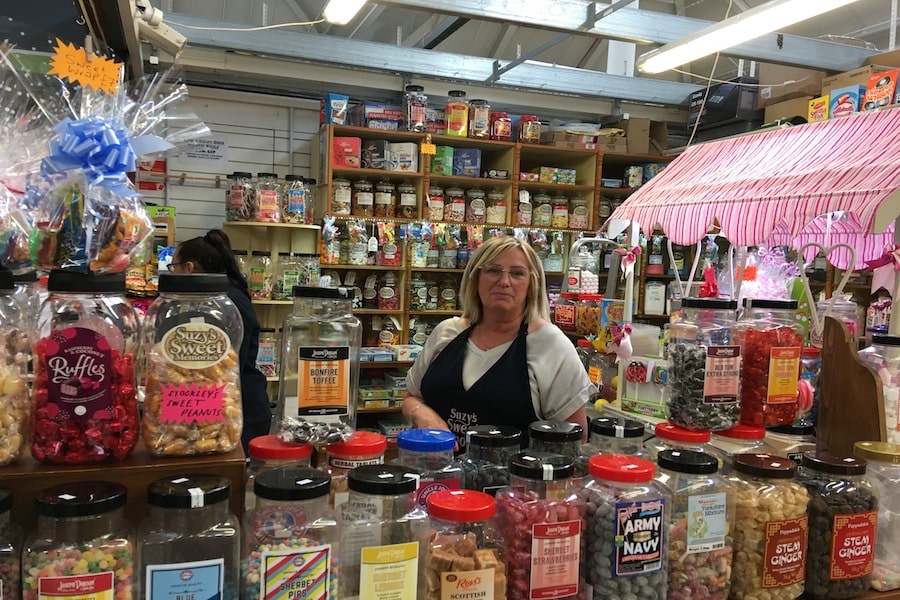Greater Manchester Market traders hit back at Council’s ‘unfair rent rise’
- Written by Charlotte Green
- Last updated 2 years ago
- Business, Community

On an overcast Thursday lunchtime, Ashton-under-Lyne’s indoor market is seemingly thriving, bustling with shoppers and diners.
Ashton-under-Lyne Indoor Market

Plenty of people have come in for their daily sandwich and coffee, or a browse around the various vendors selling everything from fresh fruit and vegetables, to kitchen cutlery and fishing jackets.
The market has been long-regarded as the jewel in Ashton’s crown, with a high trader occupancy rate and loyal customers that have kept it from experiencing the same decline faced by others across the country in recent years.
It even bounced back from a devastating fire in 2004 that torched 116 stalls and threatened to destroy the livelihoods of dozens of families.
But with each year keeping a business afloat in the market hall off Bow Street has become tougher.
Rising Energy Costs and Cost of Living Crisis for Traders
The Covid-19 pandemic, cost of living crisis and rising costs of energy and inflation have all hit stall-holders – as well as reducing the amount people have to spend.
Now many traders in Ashton Market say they could be witnessing the final nail in the coffin of the iconic market, which first received a Royal Charter in 1413 and opened on the current site in 1828.
Tameside markets rent hike
It comes as Tameside’s cabinet has agreed to increase the rent at its markets in Ashton and Hyde by 8.7 per cent, which means an increase of hundreds of pounds a year – or even more than £1,000 – for many traders.
It has also approved plans to cut its subsidy towards service charges at the markets by £67,000, which will also send back the costs to stallholders.
Under plans approved at the end of July, the rent at council-owned markets will increase the amount of rent it charges, hiking it by more than £19 per square metre.
For a large 67 sqm sized stall at Ashton Market Hall, the cost of renting will rise from £14,760 a year to £16,044 – a £1,284 increase. For a 52 sqm stall this will equate to a £996 hike.
Stallholders have now received letters asking for the increased rent, which is being backdated to April 1.
Tamside Council
Bosses at Tameside council acknowledged the ‘high risk’ that increased charges could lead to more vendors vacating the markets which are operating in a ‘challenging environment’.
But a town hall report states there is ‘no duty to provide a market’ in the borough, and they were seeking to find a ‘fair balance between the market traders and taxpayers who subsidise the market operation’.
Asked for their opinion on the rent and service charge increases, the mood among stallholders is overwhelmingly pessimistic.
“No one’s happy about it,” one man – who asks not to be named – says from behind the counter. “It’s just relentless, it never stops.”
Nat’s Bombay Kitchen
Nat Mistry, owner of Nat’s Bombay Kitchen, says the rent increase, coupled with the rise of the service charge will affect his popular business which has been running at Ashton Market for nearly 11 years.
“It’s going to have a massive impact,” he adds. “What concerns me is if they are going to backdate the rent, but we can’t backdate our prices and our sales. It’s not fair on us.
“It’s going to be really hard. A lot of traders are going to struggle and some are going to go out of business. A lot of traders are just hanging on at the moment. People will be leaving by Christmas.
“You can’t even take the wages out now at the end of the month, you can’t make any savings, it’s that bad.”
Briggs Quality Butcher

Kath Briggs, together with her husband, runs Briggs Quality Butcher, a business that has been based in Ashton Market since 1938 and spanned numerous generations.
After working in the market for 35 years, Kath tells I Love Manchester that this year is the hardest they have known.
She says she and her market colleagues were horrified when the bill, backdated for the last four months, dropped on them. “How can you pay it if the footfall is falling?,” she asks, gesturing to the now quiet rows of stalls, as the lunchtime surge fades away.
“There’s so much to worry about and now, the worry of bailiffs coming if you can’t pay. It’s ridiculous.
“There’s no care in here at all any more. It was very busy in Covid because I started running a delivery service as well, first for vulnerable people but then everyone jumped on board.
“After Covid now, where is everybody? Mainly they’ve gone back to the supermarkets.
“The electricity costs are unbelievable, the last three bills they’ve gone up by £100 each time. It’s just silly money, it’s awful.
“My husband has had to get a second job at another butchers to subsidise what’s in here. He’s doing more hours now than he’s ever done. But the loyal customers make it worth it for me.
“The market years ago was the best about. It’s so different now. It’s sad.”
Horrendous Rent Increases
Another long-term business owner in Ashton Market, who asks not to be named, describes the increased charges as ‘horrendous’.
“In a year you could come back to interview people and there might not be anybody here,” he says. “A lot of businesses in here are struggling to keep going, and I worry about them.
“It’s not just about the stall, it’s about people’s lives, being able to pay their mortgages.
“We want to thrive here. But the odds are stacked against us. We are fighting a losing battle. We need more help now than we did during Covid.”
He adds: “Ashton is a low wage area. We are trying to keep our prices as low as possible to support the community, and they are making it more and more difficult for us.
“We don’t drive away in Ferraris, we struggle with our bills as well. It’s almost like there is a disdain for local businesses.”
Suzy’s Sweet Memories stall

At Suzy’s Sweet Memories stall, which sells traditional and retro sweets, Sue Mellish says she has been working at the market for 13 years, but like others is feeling the pinch even more in 2023.
“There is not the football in the market at the moment to cover these increases. They are squeezing us all in the market,” she says.
“You can’t plan for these things. The town is dying. Maybe when the outdoor market is done up, maybe [the rent increase] could be done then where there is more footfall coming in.
“Ashton used to be thriving, these walkways would be all hustle and bustle with people. But now I’d say from 2pm this market has died a thousand deaths in the afternoon.
“We are all just trying to make a living. We just hope people will stay loyal and keep coming in, and we provide a good service to people. A lot of customers are family to us.”
A number of stallholders also highlight the impact of antisocial behaviour on the outdoor market, with people regularly street-drinking under the covered stalls or seen taking drugs or fighting, has negatively impacted trade.
Another trader, Carl, adds: “Go outside of here and you see lots of antisocial behaviour. It’s the usual, drug addicts, people drinking. Sometimes they come inside the market shouting and causing problems. It puts people off.”
On the rising rent, he says: “It’s going to affect everyone in here. I’ll be paying about £800 a year extra with all the charges. Look around the market, there’s so many empty spaces.
“They [the council] are still set in the mindset that Ashton Market is the best and it will survive, but there are better markets where you are looked after better.”
Ashton Hoodies
Benaissa Derraz, who runs Ashton Hoodies, is one of the newer stallholders in Ashton Market, having relocated from Longsight Market in the last seven months to be nearer family.
He questions why the rent is being increased now, ahead of planned major works to the Market Square and outdoor market – being funded by nearly £20m of government Levelling Up funding – which the council acknowledges will cause a ‘phase of disruption’ to traders.
“It’s not the right time to increase the rent,” he says. “When I started here trade was ok, but now it’s a lot quieter. If the rent goes up and up, who knows what will happen?”
He hopes for a change of fortunes, and an up-tick in business throughout the building. “Maybe it will change – if it improves, well, it will be very good for everybody,” the stallholder shrugs.
Rents had not been increased by the council from 2016 to 2020.
Increasing the rent by 8.7 per cent for this financial year will generate an additional £42,000 of income for the council which it says it requires to balance the books in the ‘place’ directorate.
However councillors opted against a bigger hike of 13.4 per cent which would have been in line with the Retail Price Index, the benchmark specified in this year’s council budget.
The Risk of Hiking Rents
Officers said that hiking the rents posed the potential risk of more traders vacating the markets, acknowledging the ‘challenging retail economy’ facing businesses.
“Footfall has decreased by an average of 20 per cent across the markets and shoppers spend has decreased due to the cost of living crisis,” the cabinet report states.
Currently there are 11 vacant units out of 81 in Ashton Market Hall, with Hyde Market Hall having 23 empty stalls out of 76.
“The report identifies a potential risk that increasing rents will put an additional pressure on the small businesses within the market hall which could result in some businesses deciding to leave the market,” council officers add.
“This would result in a loss of rental income and also a reduction service charge income, if these traders were not replaced.”
But opting for the lower amount of 8.7 per cent still leaves a shortfall of £22,000 which will have to be found elsewhere.
The authority has also agreed to reduce the amount of council subsidy towards service charges, which cover the costs of operating the markets such as market staff and insurance, by £67,000. It will continue to subsidise the markets by £112,00 this year.
However Tameside council is aiming to move to a full ‘cost recovery model’ for the service charge in the 2024/25 financial year, meaning the markets would pay entirely for their own service charge, with no prop-up funding from the council.
The cabinet report states: “In recent previous years, the council has exercised discretion and not applied the RPI (retail price index) increase to the rents, recognising that the market operates in a challenging environment and the importance of maintaining the commercial attractiveness of the markets.
“Rents were not increased in the four years from 2016 to 2020. Had rents been increased in line with RPI in those years, the current rent per square metre in Ashton would be £255 rather than the £220 currently being charged.”
A Tameside council spokesperson said: “Market traders pay rent for their individual unit space, as well as a service charge to cover the shared areas and direct costs of running the markets.
“The service charge is currently subsidised by the council, and will be again in 2023/24, albeit to a lesser degree.
“Each year, the council is required to review these costs and consider a fair balance between market traders, the tax payers who subsidise the market operation and the need for a legal and balanced budget.
“The council’s executive cabinet has taken the decision to retain but reduce the subsidy for the 2023/24 financial year, and increase the unit rent by the lower rate of 8.7 per cent in line with the Consumer Price Index as opposed to the higher rate of 13.4 per cent in line with the Retail Price Index which is rate stated within their contract.
“We understand the financial challenges faced by tax payers, businesses and indeed ourselves as a local authority.
“There have been no increases for the last four years and that burden has been borne by taxpayers and it should be noted we do not subsidise any other businesses, all of whom are struggling in the economic crisis.
“We believe this is a fair and reasonable decision that doesn’t simply maximise income generation through our market traders but supports them in a balanced way.”
- This article was last updated 2 years ago.
- It was first published on 4 August 2023 and is subject to be updated from time to time. Please refresh or return to see the latest version.
Did we miss something? Let us know: [email protected]
Want to be the first to receive all the latest news stories, what’s on and events from the heart of Manchester? Sign up here.
Manchester is a successful city, but many people suffer. I Love Manchester helps raise awareness and funds to help improve the lives and prospects of people across Greater Manchester – and we can’t do it without your help. So please support us with what you can so we can continue to spread the love. Thank you in advance!
An email you’ll love. Subscribe to our newsletter to get the latest news stories delivered direct to your inbox.
Got a story worth sharing?
What’s the story? We are all ears when it comes to positive news and inspiring stories. You can send story ideas to [email protected]
While we can’t guarantee to publish everything, we will always consider any enquiry or idea that promotes:
- Independent new openings
- Human interest
- Not-for-profit organisations
- Community Interest Companies (CiCs) and projects
- Charities and charitable initiatives
- Affordability and offers saving people over 20%
For anything else, don’t hesitate to get in touch with us about advertorials (from £350+VAT) and advertising opportunities: [email protected]

Strictly high-flying: Kelvin Fletcher trades dance moves for dirt jumps at Arenacross

Worker Bee: Meet Peter Hook, legendary New Order and Joy Division bassist

Hilton Manchester Deansgate’s superstar chefs shine on the world stage

How Sounds from the Other City became the UK’s most unforgettable independent festival

Piehard: where to get the best pies in and around Manchester

















